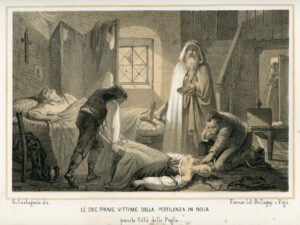
The last outbreak of the Plague on the Western European mainland occurred in 1815 in a town called Noja (present Noicattaro), on the Apulian coast of Italy.
Liborio Didonna, a gardener, was the first person who died from the contagion, two days after he showed the first symptoms, his wife Pasqua Capella succumbed two days later. When they were buried, their cause of death was still unknown, so no precautions were made, and their belongings found their way to several relatives.
When after a month the severity of the disease was identified, a very strict cordon sanitaire was imposed, consisting of three trenches guarded by armed forces, which lasted a year.
Between 700 – 800 inhabitants (about one seventh of the population) died, while 700 other patients recovered.
Lithograph by G. Castagnola / Ballagny e Figli



Joana
maart 31, 2023 at 3:23pmOther plague outbrakes were recorded in Europe, in the 20th century.
See “The Third Plague Pandemic in Europe”: https://royalsocietypublishing.org/doi/10.1098/rspb.2018.2429
Herbert J. Mattie
april 1, 2023 at 7:19amDear Joana, thank you for your comment. You are right, although it would have been useful when this article would have included a definition of the term ‘outbreak’. According to the WHO, an outbreak is ‘the occurrence of cases of disease in excess of what would normally be expected in a defined community, geographical area or season.’ To me, that excludes small-scale occurrences of the plague on ships arriving from regions where the disease is endemic. The authors have also a broader conception of continental Europe than most of us do. But still, that leaves outbreaks such as the one in Taranto in 1945.
I will edit the post so that it becomes clearer that I refer to Noja as the city where the last outbreak of the ‘historical’ plague, or the Second Pandemic occurred.
Kind regards.